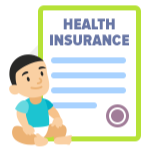Americans need affordable, quality health care – and that’s extremely apparent in the wake of the COVID-19 pandemic, the biggest public health crisis in over a century. Finding good health care at the right price point should be a priority for everyone, but it’s unfortunately not so easy. The average American spends nearly $13,500 per year on personal health care, according to the most recent estimate from the Centers for Medicare & Medicaid Services. That’s a daunting statistic considering that many people are already struggling financially due to inflation and lots of debt.
In addition, while health care in the U.S. is expensive, higher medical costs don’t necessarily translate to better results. According to research by the Kaiser Family Foundation, the U.S. lags behind several other wealthy nations in health care quality.
Conditions aren’t uniform across the U.S., though. To determine where Americans receive the best and worst health care, WalletHub compared the 50 states and the District of Columbia across 44 measures of cost, accessibility and outcomes.

Cassandra Happe, WalletHub Analyst
Main Findings
States with Best Health Care Systems
|
Overall Rank |
State |
Total Score |
Cost Rank |
Access Rank |
Outcomes Rank |
|---|---|---|---|---|---|
| 1 | Minnesota | 67.38 | 2 | 6 | 11 |
| 2 | Rhode Island | 67.00 | 17 | 1 | 6 |
| 3 | South Dakota | 65.47 | 5 | 2 | 19 |
| 4 | Iowa | 65.09 | 1 | 30 | 12 |
| 5 | New Hampshire | 64.08 | 15 | 14 | 8 |
| 6 | Massachusetts | 64.05 | 34 | 7 | 2 |
| 7 | Utah | 63.79 | 20 | 34 | 1 |
| 8 | Vermont | 63.64 | 40 | 3 | 3 |
| 9 | Maine | 63.60 | 24 | 4 | 15 |
| 10 | Colorado | 62.60 | 36 | 9 | 7 |
| 11 | North Dakota | 62.57 | 23 | 8 | 16 |
| 12 | Hawaii | 62.49 | 28 | 24 | 4 |
| 13 | Pennsylvania | 62.28 | 6 | 18 | 20 |
| 14 | Michigan | 61.95 | 4 | 31 | 17 |
| 15 | Kansas | 61.39 | 9 | 12 | 25 |
| 16 | Wisconsin | 61.04 | 37 | 5 | 13 |
| 17 | Maryland | 60.39 | 11 | 23 | 21 |
| 18 | Montana | 60.09 | 16 | 15 | 26 |
| 19 | Nebraska | 60.02 | 26 | 13 | 22 |
| 20 | Missouri | 59.38 | 7 | 11 | 37 |
| 21 | Virginia | 58.02 | 8 | 48 | 23 |
| 22 | Indiana | 57.69 | 10 | 26 | 35 |
| 23 | Idaho | 57.65 | 31 | 37 | 14 |
| 24 | Connecticut | 57.65 | 48 | 16 | 9 |
| 25 | New Jersey | 56.57 | 27 | 19 | 31 |
| 26 | Ohio | 56.40 | 12 | 33 | 33 |
| 27 | Oregon | 55.96 | 45 | 35 | 10 |
| 28 | Illinois | 55.91 | 38 | 22 | 28 |
| 29 | Kentucky | 55.57 | 3 | 10 | 49 |
| 30 | Washington | 55.32 | 49 | 45 | 5 |
| 31 | Delaware | 55.24 | 39 | 28 | 27 |
| 32 | California | 54.66 | 42 | 38 | 18 |
| 33 | Nevada | 53.89 | 13 | 43 | 40 |
| 34 | Arizona | 53.66 | 22 | 46 | 36 |
| 35 | South Carolina | 53.21 | 29 | 36 | 39 |
| 36 | New Mexico | 53.03 | 19 | 41 | 41 |
| 37 | Wyoming | 52.99 | 47 | 27 | 29 |
| 38 | New York | 52.97 | 50 | 29 | 24 |
| 39 | District of Columbia | 51.92 | 46 | 25 | 34 |
| 40 | Tennessee | 50.95 | 14 | 40 | 45 |
| 41 | North Carolina | 50.82 | 43 | 47 | 30 |
| 42 | Florida | 50.77 | 35 | 42 | 42 |
| 43 | Louisiana | 50.38 | 33 | 21 | 46 |
| 44 | Arkansas | 49.48 | 18 | 32 | 50 |
| 45 | Texas | 49.39 | 41 | 49 | 38 |
| 46 | Alaska | 49.13 | 51 | 19 | 32 |
| 47 | Oklahoma | 48.93 | 30 | 44 | 44 |
| 48 | Georgia | 48.61 | 32 | 51 | 43 |
| 49 | West Virginia | 48.46 | 44 | 17 | 48 |
| 50 | Alabama | 48.19 | 21 | 50 | 47 |
| 51 | Mississippi | 46.01 | 25 | 39 | 51 |
Note: With the exception of “Total Score,” all of the columns in the table above depict the relative rank of that state, where a rank of 1 represents the best conditions for that metric category.

- Lowest
- 1. New Hampshire
- 2. Idaho
- 3. Utah
- 4. Virginia
- 5. Maryland

- Highest
- 47. District of Columbia
- 48. Connecticut
- 49. Wyoming
- 50. Alaska
- 51. West Virginia

- Most
- 1. District of Columbia
- 2. Mississippi
- 3. Arkansas
- 4. West Virginia
- 5. Louisiana

- Fewest
- 47. Maryland
- 48. Oregon
- 49. Washington
- 50. Idaho
- 51. Utah

- Most
- 1. District of Columbia
- 2. Massachusetts
- 3. Rhode Island
- 4. New York
- 5. Connecticut

- Fewest
- 47. Utah
- 48. Nevada
- 49. Montana
- 50. Wyoming
- 51. Idaho

- Most
- T-1. District of Columbia
- T-1. Colorado
- T-1. Hawaii
- 4. Maryland
- 5. California

- Fewest
- 47. Mississippi
- 48. Kentucky
- 49. Alabama
- 50. Iowa
- 51. Tennessee

- Highest
- 1. California
- 2. Alaska
- 3. Montana
- T-4. Florida
- T-4. Texas

- Lowest
- 47. Rhode Island
- 48. Wyoming
- 49. Delaware
- 50. New Hampshire
- 51. District of Columbia

- Highest
- 1. Massachusetts
- 2. District of Columbia
- 3. Hawaii
- 4. Rhode Island
- 5. Vermont

- Lowest
- 47. Mississippi
- T-48. Florida
- T-48. Georgia
- 50. Oklahoma
- 51. Texas

- Highest
- 1. Massachusetts
- 2. Vermont
- T-3. District of Columbia
- T-3. New York
- 5. Rhode Island

- Lowest
- 47. Oklahoma
- T-48. Alaska
- T-48. Arizona
- 50. Wyoming
- 51. Texas

- Lowest
- 1. North Dakota
- 2. Vermont
- 3. Massachusetts
- 4. New Jersey
- 5. Oregon

- Highest
- 47. South Carolina
- 48. Alaska
- 49. Alabama
- 50. Arkansas
- 51. Mississippi

- Lowest
- 1. New Mexico
- 2. Arizona
- 3. California
- 4. Colorado
- 5. District of Columbia

- Highest
- 47. New Jersey
- 48. West Virginia
- 49. Maine
- 50. Iowa
- 51. Kentucky

- Lowest
- 1. Hawaii
- 2. Colorado
- 3. District of Columbia
- 4. Utah
- 5. California

- Highest
- 47. Mississippi
- 48. Kentucky
- 49. Alabama
- 50. Arkansas
- 51. West Virginia

- Lowest
- 1. West Virginia
- 2. Louisiana
- 3. Kentucky
- 4. Rhode Island
- 5. South Carolina

- Highest
- 47. Minnesota
- 48. Washington
- 49. Colorado
- 50. District of Columbia
- 51. New Mexico

- Lowest
- 1. Connecticut
- 2. Massachusetts
- 3. Hawaii
- 4. Utah
- 5. District of Columbia

- Highest
- 47. Mississippi
- 48. Alabama
- 49. Texas
- 50. West Virginia
- 51. Arkansas
In-Depth Look at the Best States for Health Care
Minnesota
Minnesota is the best state for health care, boasting the highest number of convenient care clinics per capita. It’s also relatively inexpensive to get health care in the state, as Minnesota has the fourth-lowest average out-of-pocket medical spending and the sixth-lowest average monthly insurance premium. Plus, the average dental visit costs less in only four other states.
The quality of health care matters as much as the cost, and Minnesota delivers. It has the sixth-best public hospital system in the country, and residents have the fifth-highest life expectancy. The state also has an extremely low maternal mortality rate, and it only takes around 16 minutes for the average person to be seen at the emergency room.
Rhode Island
Rhode Island is the second-best state for health care, and its residents have the lowest out-of-pocket medical spending in the country, at just 4.5% of their income. Rhode Island also has a lot of medical professionals, with the third-most physicians per capita and fourth-most nurses per capita, so it’s easier to get seen in a timely manner and get second opinions.
In addition, 94% of adults and 97% of children in Rhode Island have health insurance, the fourth-highest percentages in the country.
To top things off, Rhode Island residents clearly have good access to preventative medical care. The Ocean State has the fourth-lowest percentage of people without a routine doctor visit in the past two years and the sixth-lowest share of people who haven’t visited a dentist in the past year. The state also has a very high vaccination rate for children, which contributes to the second-lowest child death rate in the nation.
South Dakota
South Dakota is the third-best state for health care, with the 8th-lowest out-of-pocket medical spending in the country. Residents also have the second-lowest average cost per inpatient day at community hospitals, at around $1,700.
The Mount Rushmore State is especially good for people who need to visit the emergency room, with the third-lowest wait time in the country. In addition, only 0.3% of patients leave the emergency room without being seen, the lowest percentage in the nation. People with immediate but less dire issues can also benefit from the fact that South Dakota has the second-most urgent care centers per capita that are certified by the Urgent Care Association of America.
To top things off, South Dakota is one of the many states that have adopted telehealth services. It also has the lowest prevalence of strokes and the fourth-lowest prevalence of type-2 diabetes in the country.
Ask the Experts
As Americans anticipate changes to their health care in both the short and long terms, we asked a panel of experts to weigh in with their thoughts on the following key questions:
- What tips do you have for a person looking to find the right balance between the cost of premium and level of coverage?
- What are the most important steps Americans can take to minimize health-related expenditures?
- What is your opinion on Medicare-for-All?
- What are the major issues facing healthcare in 2024?
Ask the Experts
David McDaniel Keller Professor of Economics and Business and Public Policy Fellow – University of Chicago Booth School of Business
Read More
Ph.D. – Professor and Kaye Insurance Fellow, Department of Finance – Florida Atlantic University College of Business
Read More
Practitioner in Residence, School of Health Sciences – University of New Haven
Read More
Professor, Department of Finance and the Minnesota Insurance Industry Chair of Health Finance in Carlson School of Management – University of Minnesota
Read More
Professor of Practice, School of Mathematics and Statistics, College of Science – Rochester Institute of Technology
Read More
Methodology
In order to determine the best and worst states for health care, WalletHub compared the 50 states and the District of Columbia across three key dimensions: 1) Cost, 2) Access and 3) Outcomes.
We evaluated those dimensions using 44 relevant metrics, which are listed below with their corresponding weights. Each metric was graded on a 100-point scale, with a score of 100 representing the best health care at the most reasonable cost.
Finally, we determined each state and the District’s weighted average across all metrics to calculate its overall score and used the resulting scores to rank-order our sample.
Cost – Total Points: 33.33
- Cost of Medical Visit: Full Weight (~5.56 Points)
- Average Hospital Expenses per Inpatient Day at Community Hospitals: Full Weight (~5.56 Points)
Note: Includes all operating and non-operating expenses for registered U.S. community hospitals, defined as nonfederal short-term general and other special hospitals whose facilities and services are available to the public. - Cost of Dental Visit: Full Weight (~5.56 Points)
- Average Monthly Insurance Premium: Full Weight (~5.56 Points)
- Share of High Out-of-Pocket Medical Spending: Full Weight (~5.56 Points)
Note: This metric measures the share of the population aged 64 and younger with high out-of-pocket medical spending relative to their annual income. - Share of Adults with No Doctor Visits Due to Cost: Full Weight (~5.56 Points)
Access – Total Points: 33.33
- Quality of Public Hospital System: Full Weight (~1.39 Points)
Note: This metric is based on the Centers for Medicare & Medicaid Services’ ranking of public hospital systems. - Hospital Beds per Capita: Full Weight (~1.39 Points)
- Average Response Time from EMS Notification to EMS Arrival (minutes): Full Weight (~1.39 Points)
- Average Emergency-Room Wait Time: Full Weight (~1.39 Points)
- Time Before Admission: Full Weight (~1.39 Points)
Note: This metric refers to the average time, in hours, patients spend in the emergency room before being admitted to the hospital. - Share of Patients Leaving the ER Without Being Seen: Full Weight (~1.39 Points)
- Physicians per Capita: Full Weight (~1.39 Points)
- Geriatricians per Population Aged 65 & Older: Full Weight (~1.39 Points)
- Nurse Practitioners per Capita: Full Weight (~1.39 Points)
- Physician Assistants per Capita: Full Weight (~1.39 Points)
- EMTs & Paramedics per Capita: Full Weight (~1.39 Points)
Note: “EMTs” refer to emergency medical technicians. - Urgent-Care Centers per Capita: Full Weight (~1.39 Points)
Note: “Urgent-Care Centers” include those certified by the Urgent Care Association of America (UCAOA). - Convenient Care Clinics per Capita: Full Weight (~1.39 Points)
- Medicare Certified Rural Health Clinics per Rural Population: Full Weight (~1.39 Points)
Note: Medicare Certified Rural Health Clinics (RHCs): RHCs provide primary care and preventive services in rural, underserved areas. They can be public, non-profit, or for-profit facilities, must be staffed at least 50% of the time with Nurse Practitioners, PAs, or Certified Nurse Midwives, and must meet certain other facility and quality requirements. - Dentists per Capita: Full Weight (~1.39 Points)
- Share of Medical Residents Retained: Full Weight (~1.39 Points)
- Medicare Acceptance Rate Among Physicians: Full Weight (~1.39 Points)
- Medicaid Acceptance Rates Among Physicians: Full Weight (~1.39 Points)
- Share of Insured Adults: Full Weight (~1.39 Points)
Note: “Adults” include the population aged 19 to 64. - Share of Insured Children: Full Weight (~1.39 Points)
Note: “Children” include the population aged 0 to 18. - Share of Adults with No Personal Doctor: Full Weight (~1.39 Points)
- Status of State ACA Innovation Waivers: Full Weight (~1.39 Points)
Note: This metric measures if a state has either released a draft, enacted a legislation or has had an Innovation waiver approved by federal government. - Adoption of Telehealth Services: Full Weight (~1.39 Points)
Note: “Telehealth,” as defined by the Health Resources and Services Administration (HRSA) of the U.S. Department of Health and Human Services, is the use of electronic information and telecommunications technologies to support and promote long-distance clinical health care, patient and professional health-related education, public health and health administration. This composite metric includes Patient Setting, Technology, Provider Types and Medicaid Coverage. - Patient Encounters in Community Health Centers per Capita: Full Weight (~1.39 Points)
Note: “Community Health Centers” refer to Federally Qualified Health Centers (FQHCs), which the U.S. Department of Health and Human Services defines as “all organizations receiving grants under Section 330 of the Public Health Service Act (PHS). FQHCs qualify for enhanced reimbursement from Medicare and Medicaid, as well as other benefits.”
Outcomes – Total Points: 33.33
- Infant Mortality Rate: Full Weight (~2.22 Points)
- Child Mortality Rate: Full Weight (~2.22 Points)
- Maternal Mortality Rate: Full Weight (~2.22 Points)
- Share of Patients Readmitted to Hospitals: Full Weight (~2.22 Points)
Note: This metric measures the percentage of patients readmitted within 30 days following discharge from a hospital. - Share of Hospitalized Patients Discharged Without Instructions for Home Recovery: Full Weight (~2.22 Points)
- Share of Hospital Patients Who Did Not Receive Patient-Centered Care: Full Weight (~2.22 Points)
- Life Expectancy: Double Weight (~4.44 Points)
- Cancer Incidence Rate: Full Weight (~2.22 Points)
- Stroke & Heart Disease Rate: Full Weight (~2.22 Points)
- Share of Adults with Type 2 Diabetes: Full Weight (~2.22 Points)
- Share of At-Risk Adults with No Routine Doctor Visit in Past Two Years: Full Weight (~2.22 Points)
- Share of Adults with No Dental Visit in the Past Year: Full Weight (~2.22 Points)
- Share of Children with Medical & Dental Preventive-Care Visits in Past Year: Full Weight (~2.22 Points)
Note: “Children” include the population aged 0 to 17. - Share of Non-Immunized Children: Full Weight (~2.22 Points)
Note: “Children” include the population aged 0 to 35 months.
Sources: Data used to create this ranking were collected as of July 1, 2024 from the U.S. Census Bureau, Bureau of Labor Statistics, Council for Community and Economic Research, The Commonwealth Fund, Trust for America's Health and Robert Wood Johnson Foundation, U.S. Department of Agriculture, Child and Adolescent Health Measurement Initiative, United Health Foundation, Centers for Medicare & Medicaid Services, Health Resources & Services Administration, ProPublica, Association of American Medical Colleges, Centers for Disease Control and Prevention, American Telemedicine Association, Urgent Care Association of America, Convenient Care Association, Kaiser Family Foundation, State Health Access Data Assistance Center, American Board of Medical Specialties, State Health and Value Strategies, County Health Rankings, and National Highway Traffic Safety Administration.







WalletHub experts are widely quoted. Contact our media team to schedule an interview.